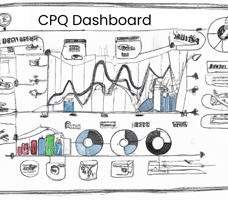"Most businesses wrongly believe they’ve mastered CPQ metrics if they’re seeing revenue growth....
KPI: Metrics that Matter in Configurate-Price-Quote
Is traditional CPQ dead? Some would argue that without the right KPIs, even the most advanced CPQ systems are like sports cars without speedometers. As we dive into the transformative era of CPQ, understanding the metrics that truly drive success becomes paramount. And it's not just about the flashy numbers. Let's unveil the unsung KPI heroes that businesses are missing out on.
In the ever-evolving world of CPQ (Configurate-Price-Quote), the power lies not just in its ability to streamline sales processes or in the ease it offers in generating quotes. It's in the metrics—the underlying KPIs that guide businesses toward more lucrative decisions.
1. The Overlooked Essence of CPQ KPIs
The bread and butter metrics like 'Quote-to-Cash Time' and 'Average Deal Size' are commonly tracked. However, it's metrics like 'Margin Leakage' and 'Time to First Quote' that provide deeper insights into process efficiency and profitability.
2. CPQ KPIs: Beyond the Basics
-
Upsell & Cross-sell Rates: The ability of the CPQ system to recommend relevant product combinations can be tracked by monitoring the rates of upsells and cross-sells.
-
Configuration Error Rates: CPQ isn't just about speed; it's about accuracy. By tracking error rates, businesses can pinpoint areas in the configuration process that need fine-tuning.
3. How KPIs Shape Business Decisions
A business that doesn't adapt its strategies based on its KPIs is essentially flying blind. Here are a couple of ways businesses have shifted gears based on KPI insights:
-
Quote-to-Conversion Time: A longer than average time might indicate a need for more training for the sales team or a revamp in the configuration options provided.
-
Customer Response Time: If this KPI shows a lag, it's a sign that there might be bottlenecks in the approval process or internal communication hiccups.
4. The Future: Predictive Analytics and CPQ KPIs
With the integration of AI and machine learning, predictive analytics are set to revolutionize how businesses interpret CPQ KPIs. This means not just understanding current performance but accurately forecasting future trends based on these metrics.
5. Real-World Case Study: The Transformational Power of KPIs
Imagine a leading tech firm noticing a decline in its 'Profit Margin per Sale'. While most would panic, they dove deeper into their CPQ KPIs. They discovered that the 'Time to First Quote' was unusually long, leading to delayed sales processes. By revamping their configuration process and training their team, they managed to not only improve their profit margins but also enhance customer satisfaction.
In wrapping up, let's circle back to our initial provocation. No, traditional CPQ isn't dead. But without a keen eye on the right KPIs, it might as well be. It's not about abandoning the traditional but embracing the transformative power of metrics to breathe new life into CPQ systems.
So, as we push forward in this dynamic era, let's ensure we're not just racing but racing with a clear vision of the finish line.




